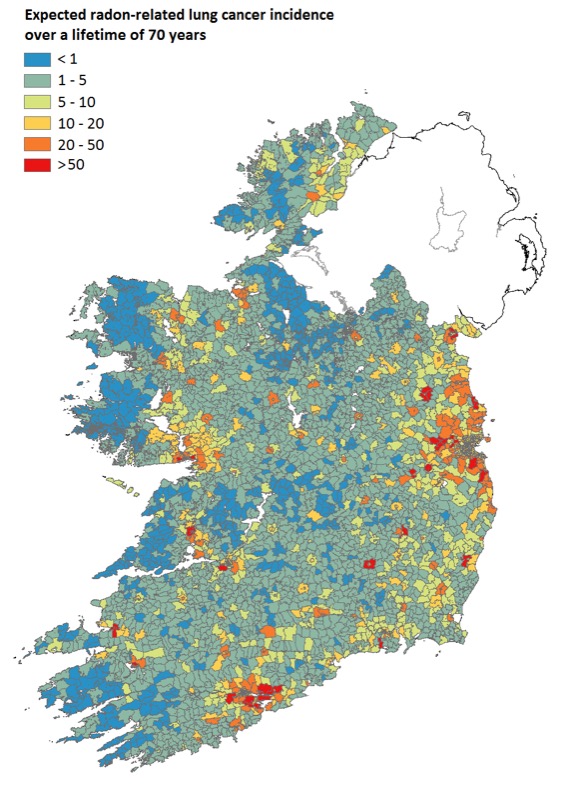Research pinpoints radon priority areas based on expected lung cancer incidence
Posted on: 30 April 2018
A new assessment using 32,000 residential radon measurements throughout Ireland points to specific radon priority areas. The novel approach combines average indoor radon concentration by small area with population data from the latest census to produce a map showing the expected distribution of radon-related lung cancers. It is the first time a national-scale map has been produced in this way for Ireland, or any other country.
Average indoor radon concentrations by Electoral Division (the geographic scale used) range from 21 to 338 becquerels per cubic meter, although levels much lower or higher than this may be found in individual homes. Using known relationships between radon exposure and an increased risk in developing lung cancer, the researchers estimate that around 280 of the approximately 2,300 lung cancer cases in Ireland per year are related to indoor radon exposure.
In this new study, the distribution of expected lung cancers related to radon exposure are used to define “priority areas”. Although the number of expected radon-related lung cancers per Electoral Division and per year are very low, such a designation emphasises some small areas within counties Dublin, Meath, Kildare, Wicklow, Wexford, Kilkenny, Cork, Kerry, Limerick, Clare and Galway. Even with lower than average indoor radon concentrations, more populated areas have a higher “collective dose”, so will have a higher number of expected lung cancer cases.

Associate Professor in Isotopes and the Environment in the School of Natural Sciences at Trinity College Dublin, Quentin Crowley, co-authored the research recently published in the journal Environment International.
Professor Crowley said: “Our research indicates that measures to protect against the harmful effects of radon could be refined if demographic data are considered. We demonstrate the importance of considering population density and changes in the total population over time as part of the evaluation for long-term effects of radon exposure to the general public. Such an approach will help to define a rigorous National Action Plan to reduce radon exposure and consequentially reduce the number of radon-related lung cancer cases.”
Post-Doctoral Researcher in the School of Natural Sciences at Trinity, Javier Elío, added: “We have produced a map indicating where the highest radon-related lung cancer incidence is expected. This is a radically different approach as it is the first time that the adverse health effects of radon exposure are taken into account for defining Radon Priority Areas. Our methodology is specifically designed to meet EU legislative requirements for radiation protection of the general public.”
Associate Professor of Epidemiology in the School of Medicine at Trinity, Lina Zgaga, said: “The key value of this research is that it enables targeted action – precise identification of high-risk areas is the first step to counteracting the harmful effects of radon on health.”
Principal Geologist at Geological Survey Ireland, Ray Scanlon, said: “This key research shows that the distribution of this naturally occurring but potentially harmful gas is highly variable around the country. Radon emits constantly from the rocks and soils beneath our feet and seeps into our houses. Identifying local hot spots is a key step to reducing lung cancer incidence in Ireland.”
The research was financed by the Irish Research Council (IRC), through the Enterprise Partnership Scheme Postdoctoral Fellowship 2015 (EPSPD/2015/46), and co-financed by the Geological Survey, Ireland (GSI). The IRC is not responsible for any use that may be made of the information contained therein. The data used in this project have been collated by the Environmental Protection Agency of Ireland, and GSI.
About radon
Radon is a naturally occurring radioactive gas, which does not have any taste, odour or colour. It can only be detected using specialised equipment. Radon escapes from the ground and dissipates to the atmosphere where it is diluted to very low concentrations, or it may accumulate to higher concentrations in enclosed spaces.
Indoor radon levels vary from house to house depending on location, construction type and usage. Radon is the principal source of ionising radiation exposure, representing over 56% of the overall dose received by the Irish population, and exposure to radon increases the likelihood of developing lung cancer. Globally, radon exposure is the second highest cause of lung cancer after smoking.
EU member states are legally required to have a national action plan in place in order to protect the general population against the effects of long-term radon exposure, even if this exposure is at a relatively low level. EU Directive 2013/59/Euratom came into effect in early February 2018, and this resulted in the lowering of the reference level of indoor radon in the workplace in Ireland from 400 to 300 becquerels per cubic meter. The national reference level of domestic indoor radon has remained unchanged at 200 becquerels per cubic meter. When concentrations greater than these reference levels are encountered, remediation is recommended. A pilot scheme to help with costs is currently being rolled out.
Previous research has calculated that for every 100 becquerels per cubic metre increase in indoor radon, there is about a 15% increase in the risk of developing lung cancer.
About radon monitoring and protection
Detailed information on radon and its risks, including information on how to get your home or workplace tested for radon is available on the EPA’s website at: http://www.radon.ie/ or via Freephone 1800 300 600.
